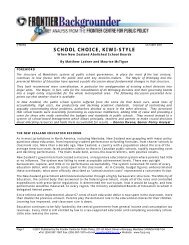POLICYSERIES - Frontier Centre for Public Policy
You also want an ePaper? Increase the reach of your titles
YUMPU automatically turns print PDFs into web optimized ePapers that Google loves.
P O L I C Y S E R I E S<br />
FCPP POLICY SERIES NO. 58 • MAY 2009<br />
Introduction<br />
The issue of child care is never far from the<br />
news, or from social policy discussions. A<br />
major federal role in child care was a key<br />
issue in the 2006 and 2008 federal elections.<br />
In each case voters were presented with<br />
a distinct choice between national daycare<br />
programs as planned by the Liberals and<br />
NDP or direct payments to families as<br />
promoted by the Conservatives.<br />
Significantly, the 2006 election result led<br />
to the dismantling of a $5-billion fiveyear<br />
national daycare strategy and the<br />
introduction of the Universal Child Care<br />
Benefit, which provides a monthly $100<br />
payment <strong>for</strong> every child under the age of six<br />
in Canada. This outcome suggests a revealed<br />
preference among Canadian voters <strong>for</strong><br />
greater choice in child care.<br />
However, it remains the case that many<br />
parents still require or desire centre-based<br />
care. And numerous lobby groups advocate<br />
<strong>for</strong> increased federal and provincial expenditures<br />
on child care on the grounds that<br />
there is a shortage of regulated spaces in<br />
the country. Given this argument, what is<br />
the best way to provide parents with greater<br />
access to licensed child care spaces? And<br />
what role should governments and markets<br />
play in meeting this need?<br />
Canada boasts a wide variety of experience<br />
in the provision of child care. As child care<br />
is predominately a provincial responsibility,<br />
there is a range of policies from the large,<br />
publicly-funded mandate of Quebec’s<br />
heavily-subsidized $7-per-day program to<br />
predominately private systems in the Atlantic<br />
provinces. One key variable in child care<br />
policy across the country is the treatment<br />
of <strong>for</strong>-profit daycare centres. Nationwide,<br />
<strong>for</strong>-profit centres comprise 20 percent of<br />
total capacity; some provinces have a majority<br />
commercial provision while others have<br />
virtually none.<br />
Differences in <strong>for</strong>-profit child care coverage<br />
across provinces are typically the product of<br />
different government policies with respect<br />
to child care subsidies. Some provinces<br />
discriminate against the commercial sector<br />
by denying or limiting access to such<br />
subsidies. Others provide equal access.<br />
The arguments made against <strong>for</strong>-profit<br />
daycare vary. It is variously claimed that<br />
commercial organizations are undeserving<br />
of government subsidies, that they provide<br />
poor quality child care services or that it<br />
is simply unethical to permit profit-making<br />
organizations to look after children.<br />
It is a frequent demand of many vocal lobby<br />
groups — and in particular public sector<br />
unions — that federal and provincial daycare<br />
money be spent exclusively on non-profit,<br />
unionized daycare programs.<br />
This backgrounder examines the diverse<br />
experience of the three Prairie provinces<br />
with respect to child care coverage, quality<br />
and the debate between <strong>for</strong>-profit and nonprofit<br />
daycares. It provides evidence on what<br />
works and what doesn’t, both <strong>for</strong> parents<br />
and taxpayers.<br />
LITTLE CRECHE ON THE PRAIRIES<br />
5<br />
© 20O8<br />
FRONTIER CENTRE


















